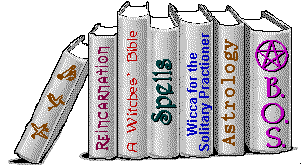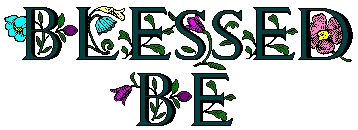� � The following are simple directions
for making herbal remedies. �This is to give you a basic feel for what
it you are doing. �It is expected that during the course of your studying
you will experiment with different dosage levels on your own to find which
amounts of herb(s) work best for you and those you are trying to help.
� � The traditional herbalist, even the non-magickal one, will
meditate upon their work as they are preparing their infusion, decoction
what-have-you and then again when the work is completed. �In this way
your learning is forever continued and you will come to find that you are
more (to use an old 60's term) �in tune' with yourself and your work.
�You will record in your diary any feelings or images or thoughts which
occurred to you while meditating.
INFUSIONS
� �For the purpose of making an infusion the water is boiled FIRST
and then poured over the herb(s). �A standard infusion is a moderate
to strong tea and is used when making more than one preparation at a time,
for instance if someone has a cold and the directions state they should have
intake of a certain infusion two or three times a day. �You may make
the entire dose of infusion in the morning and store in the refrigerator
to give out during the course of the day. �Do not store infusions for
more than three days in the frig.
� �
� � Making infusions causes all the healing properties of an herb
to be extracted into the water, those that can be extracted into water anyway,
we'll discuss that more later. �The water is the fixative or base property
into which the healing properties are extracted. � The most standard
method of making an infusion is one ounce of herb(s) to a pint (two cups)
of boiling water. �Be sure the water is already boiling before pouring
over the herbs. �Allow the mixture to steep fifteen to twenty minutes
covered, strain through your filter and then give to whomever it is you've
made
it for.
� �As I said it is expected you experiment, you may find this dosage
too strong or too weak for
any give condition. �In time you will come to know your herbs and experiment
on your own.
Until you do, it is best to use either the above directions or a weaker version
thereof.
DECOCTIONS
� � Are much like an infusion except in this case the herb(s) are
added to cold water and then boiled for a period of fifteen to twenty minutes.
�This method is preferred when working with
bark, roots and seeds, parts of the plants which are tougher
and will not extract easily with a standard infusion. �Be sure to place
a cover on the boiling herb(s) so that medicinal properties are not carried
away in the steam. �As in an infusion the standard dose is one ounce
herb(s) to one pint (two cups) boiling water.
� �
� � Because of the nature of the parts of the plant you will be
working with for making decoctions the flavor will be much stronger than
that of an infusion and you may wish to add some type of aromatic herb to
lighten the flavor and make it more to your liking. �For this purpose
use 3/4
ounce of medical herb to 1/4 ounce aromatic. �Or if you
like you may sweeten with a bit of all natural honey.
� �If there is to be more than one ingredient in the decoction
start with the toughest parts first, ie, bark and root and then in a few
minutes add stem or seeds. �If there are to be leaves and/or flowers
in the mixture add them in at the last two minutes or so.
POULTICE
� �Is a mixture applied externally to the skin only. �It can
be a rather messy process but it is essential in the
healing of cuts, scrapes, minor burns and bruising. �You will need your
infuser a wooden spoon or other tool with which to lift the mess and plenty
of gauze.
� � Stamp your selected herb(s) lightly, this means to lightly
crush them. Pour boiling hot water over your selected herb(s) just enough
to cover and wet them we are not trying to extract any of the properties
from this at this point as this would be contrary to what we are trying to
achieve.
Once all is evenly wet removed from your infuser with the wooden spoon and
place onto gauze
bandaging. �Place directly on affected area.
OINTMENTS
� � An ointment is made by macerating the herb(s) in a fatty fixative
such as lanoline or vegetable fat. �This process is done by hearing
the fixative until it is warm but not boiling and then immersing your ground
herb(s) into it. �Once done the mixture can then be gently heated more
than once and allowed to cool. �The chemical properties which are fat
soluble are extracted into the fatty fixative. �When you feel satisfied
that the most amount of properties has been reached for your mixture pour
the entire thing through the filter. �This will drain very slowly.
�Once it is
filtered place it into a storage container with tight fitting
lid, allow to cool completely before capping. �This same process is
used when making salves.
WASHES
� �Are nothing more than cooled infusions. �They are used
to cleanse an area which has been cut, scraped or burned before applying
another herb to the surface of the skin.
TINCTURES
� � Are a source of confusion among herbalist.
�The most basic method for making an infusion is
to throughly stamp four ounces of desired herb(s) and then add to four to
eight ounces of alcohol.
That's DRINKING alcohol...vodka, gin, brandy, rum are all good fixatives
for this purpose. �Be sure the alcohol is at LEAST 80 proof.
�Depending on your personally you may then add half as much water (four
ounces) to the mixture. �Place in a large container with very tight
fitting lid. Shake DAILY for two weeks and keep stored in a cool dark place.
�For the Magickal Herbalist this process is begun on the new moon and
completed on the full moon. �At the end of two weeks strain the whole
thing through your filter and store in a clean dark container. �These
preparations are best when making remedies for long term storage as they
last for at least one year due to the alcohol content. �When administering
if alcohol is not desired simply add the correct dosage to 1/4 cup of boiling
water to allow evaporation of the alcohol.
MACERATING
� � As we said the term means the herb has been steeped in some
sort of fatty substance. �Herbal oils can be made for massage and as
liniment in this manner. � Traditionally, olive oil was used as the
fixative but well, it smells like olive oil. �Other fixatives for fatty
purposes are sunflower oil or sesame oil, grapeseed oil, coconut oil, apricot
oil, jojoba oil. �Be sure to check all properties for
fixatives carefully before deciding on one. �We will
discuss fixatives more in the OILS section.
� �MASCERATING is accomplished either with or without heat it depends
upon your patience and how much time you have to work with. If you need them
quickly then bring the mixture gently up to hot but DO NOT BOIL and then
allow to cool. �This process is done several times over the course of
the day. �When you are ready then strain through your filter and use.
� �To do this without heat is simply to immerse the herb(s) into
the fixative in a dark jar with a tight fitting lid, much as you would for
tincture. �Shake the bottle at least once a day and allow to
sit in a cool dark place for upwards to a month. �You
must be absolutely positive that the herb(s) are clean and the container
as sterile as possible before starting! �Bacteria quickly grow in this
atmosphere. �You must also be sure that the final storage jar and lid
are also as sterile as possible before finishing the process.
 Drop me�an E-MAIL!
Drop me�an E-MAIL!
 Return
to�Magickal Herbalism Return
to�Magickal Herbalism
 Visit the Library
Visit the Library
 Take
a Magickal Odyssey Take
a Magickal Odyssey
|